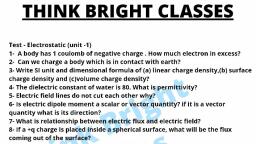Question 2 :
What is the SI prefix for $10^{-12}$ multiples and submultiples of a unit?
Question 5 :
Give the formulae of the compounds formed from carbon and oxygen.
Question 11 :
Compute the ratio by mass of the combining elements Magnesium sulphide.
Question 12 :
If one mole of carbon atom weighs 12 g, what is the mass (in gram) of 1 atom of carbon?
Question 14 :
When 3.0 g of carbon is burnt in 8.0 g of oxygen, 11.00 g of carbon dioxide is produced. What mass of carbon dioxide will be formed when 3.00 g of carbon is burnt in 50.0 g of oxygen?
Question 15 :
Calculate the number of molecules of sulphur ($S_8$) present in 16 g of solid sulphur.
Question 16 :
Which of the following scientist identified the 'Electrons' in the structure of an atom ?
Question 17 :
One electron is present in the outer most shell of the atom of an element X. What would be the nature of charge on the ion formed if this electron is removed from the outermost shell ?
Question 18 :
Calculate the number of neutrons present in the nucleus of an element X which is represented as $_{15}^{31}X$.
Question 19 :
State true or false: Helium atom has 2 electrons in its valence shell but its valency is not 2.
Question 20 :
Which of the following correctly represent the electronic distribution in the Mg atom?
Question 21 :
<img style='object-fit:contain' src='https://teachmint.storage.googleapis.com/question_assets/cbse_ncert/61b1d2b1f59b460d7261f60a.JPG' />
Which of the above in the figures do not represent Bohr's model of an atom correctly?
Question 22 :
Which of the following scientist identified the 'Canal rays' in the structure of an atom ?
Question 23 :
Dalton’s atomic theory successfully explained:
(i) Law of conservation of mass
(ii) Law of constant composition
(iii) Law of radioactivity
(iv) Law of multiple proportion
Question 24 :
Which of the following scientist identified the 'Neutron' in the structure of an atom ?
Question 25 :
Which of the following statements about Rutherford’s model of atom are correct?
(i) considered the nucleus as positively charged
(ii) established that the $\alpha$–particles are four times as heavy as a hydrogen atom
(iii) can be compared to solar system
(iv) was in agreement with Thomson’s model
Question 26 :
The atomic number of calcium and argon are 20 and 18 respectively, but the mass number of both these elements is 40. What is the name given to such a pair of elements?
Question 27 :
Which of the following correctly represent the electronic distribution in the Mg atom?
Question 29 :
In response to a question, a student stated that in an atom, the number of protons is greater than the number of neutrons, which in turn is greater than the number of electrons. Do you agree with the statement ? (Yes/No)
Question 30 :
Which of the following statements about Rutherford’s model of atom are correct?
(i) considered the nucleus as positively charged
(ii) established that the $\alpha$–particles are four times as heavy as a hydrogen atom
(iii) can be compared to solar system
(iv) was in agreement with Thomson’s model












































